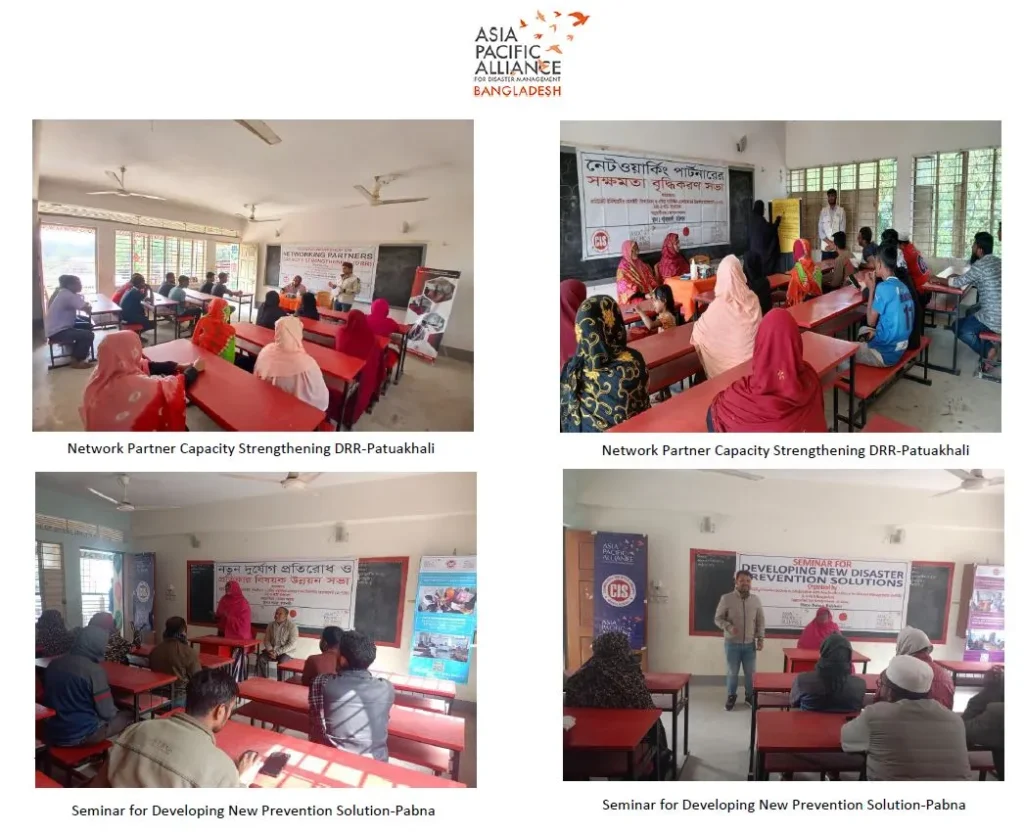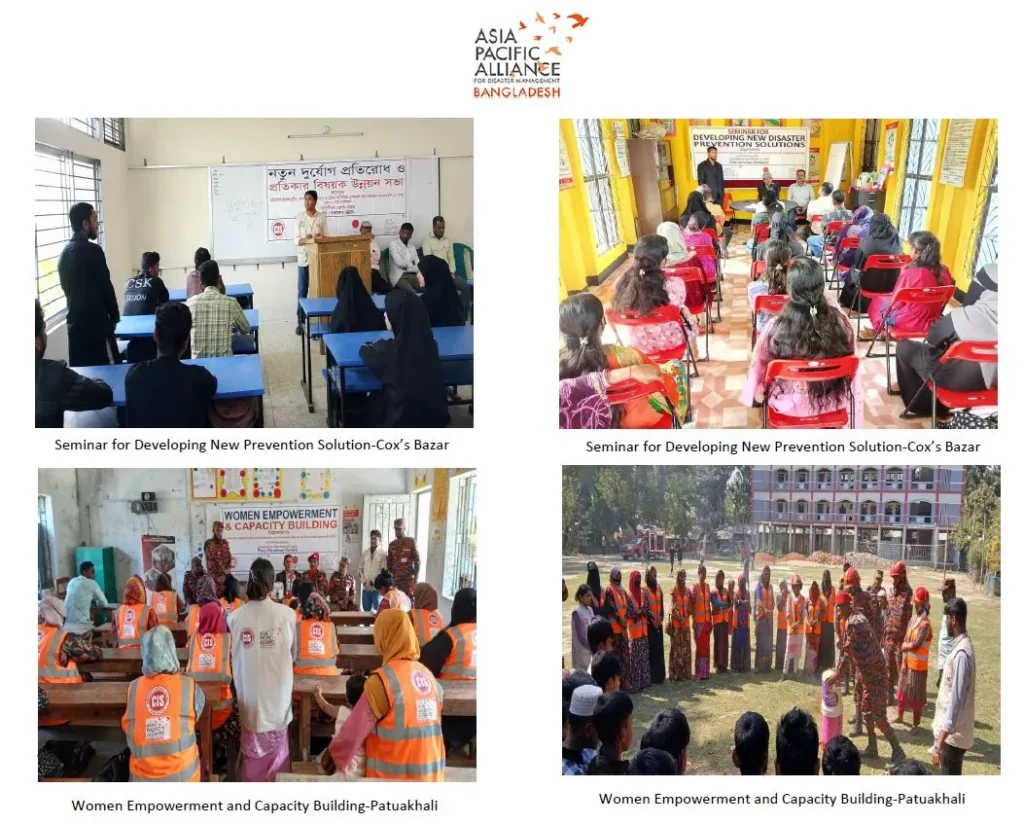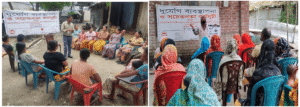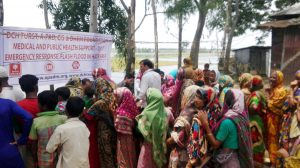Project Title: Strengthening Capacity for Sustainable Disaster Management Network by involving multi-sectoral platform Project Period: 17 January, 2024– 16 January, 2025 (12 month)
- Project Activities and Accomplishments
Bangladesh’s historical narrative, both before and after its independence, is heavily influenced by a range of disasters, largely driven by natural hazards. Situated near the Bay of Bengal, the nation faces the frequent threat of tropical cyclones that originate in the Indian Ocean. These powerful storms intensify as they approach the Southeast Asian region, with Bangladesh being one of the most affected countries. Storms are the most common disaster type encountered by the nation and have historically caused widespread devastation. The geographical makeup of Bangladesh, characterized by its extensive river delta systems and a monsoon climate, significantly heightens the risk of flooding. These floods rank as the second most common disaster affecting the country, often exacerbated by storm surges associated with cyclones. In addition to these challenges, Bangladesh is also vulnerable to landslides that typically occur in the wake of storms and heavy rainfall, alongside other hazards like earthquakes, extreme temperatures, and widespread epidemics that can arise in the aftermath of such disasters. The impacts of climate change are becoming increasingly apparent, further exacerbating Bangladesh’s susceptibility to these hazards.
A-PAD Bangladesh initiated its project in January 2023, with ongoing efforts continuing from January 17, 2024, aimed at enhancing capacity in disaster management. The organization engages with various sectors, including local communities, community leaders, stakeholders, and government officials, through continuous training sessions focused on disaster management. To facilitate these training programs, A-PAD Bangladesh staff organized small community meetings to share insights on disaster preparedness and to introduce participants to the activities of A-PAD Bangladesh. The organization operates across eight divisional areas.
In each division, there is one health worker responsible for conducting home visits to raise awareness within the local community regarding fundamental disaster management issues. These health workers also disseminate crucial information concerning government directives or any disaster-related announcements to the community. As of January 2025, A-PAD Bangladesh has successfully benefited a total of 1,869 individuals.
A-PAD Bangladesh also participated in coordination meetings held in the eight divisions at the Office of the Deputy Commissioner. These meetings included various NGOs that presented their activities and discussed future initiatives in collaboration with government bodies and NGO partners.
1. Strengthening of disaster risk reduction and disaster response system functions through the Emergency Disaster Management Coordination Center | ||
Activities | ( Outcome 1 ) The Emergency Disaster Management Coordination Center operated under this project will function as a disaster response base in each region, leading to the disaster risk reduction in the community and the strengthening of its disaster response system.: | Project Status: Achievements vs Outcome: If the activity is behind the schedule, please write the reason. |
1-1 Operation of Emergency Disaster Management Coordination Centers Target:Local communities 10 people×25 days×8 divisions×12 months =24,000 people | 【Indicators of Outcome】 1-1 The Emergency Disaster Management Coordination Center will be used for coordination meetings among partner organizations and relevant stakeholders during normal times, and will also serve as a center for health and public health guidance for the local residents. In the time of emergency, health services will be provided by emergency health workers. The Emergency Disaster Management Coordination Center will be used by 24,000 local residents (annual average) in the target area. (Indicator:number or visitors, record of services provided) 1-2 Through the Disaster Management Awareness Program, community residents will receive the latest disaster information and knowledge on how to respond to disasters, and people’s awareness of disaster prevention and response will be increased. (Indicator:Community disaster preparedness report) | Total 1,044 people visited to the Disaster Management Coordination Center to discuss about disaster preparedness and health related issues. Dhaka: 120 Persons Cox’s Bazar: 118 Persons Pabna: 127 Persons Bagerhat: 108 Persons Patuakhali: 130 Persons Habiganj: 168 Persons Rangpur: 120 Persons Netrokona: 153 Persons Total = 1,044 Persons |
1-2 Disaster Management Awareness Program Target:Local communities, Community leaders, Local NGOs, Private company workers, government officials 15 people × 8 divisions × 4 times ×12 months =5,760 people | A-PAD Bangladesh conducted Disaster Management Awareness programs at the 8 divisional areas where 515 persons have participated. Total 4 times training organized at each divisional areas. Dhaka:15 Participantsx 2 Sessons= 30 Participants Cox’s Bazar: 15 Participantsx 2 Sessons= 30 Participants Pabna: 15 Participantsx 2 Sessons= 30 Participants Bagerhat: 15 Participantsx 2 Sessons= 30 Participants Patuakhali: 15 Participantsx 2 Sessons= 30 Participants Habiganj: 15 Participantsx 2 Sessons= 30 Participants Rangpur: 15 Participantsx 2 Sessons= 30 Participants | |
|
| Netrokona: 15 Participants x 2 Sessons= 30 Participants |
2. Expansion of disaster management network to improve community vulnerability | ||
| (Outcome 2)The network of NPF will be expanded and the capacity of each region for disaster prevention and response will be strengthened. |
|
2-1 Network Partner Meeting Target : Local communities, Community leaders, Local NGO, Private Company Workers, Government officials 50 people × 5 villages × 8 divisions = 2,000 people | 【Indicator of Outcome】 2-1 Strategies, mechanisms, and action plans for disaster reduction cooperation are developed in each region through discussions at network partner meetings, and a framework for disaster reduction cooperation is established. (Indicator:Strategic Plan) 2-2 MOUs signed with at least 5 new organizations, including private companies, in A-PAD Bangladesh NPF to expand the network (Indicator:number of new MOUs signed) 2-4 Resources possessed by A-PAD BGD partner organizations are provided in emergency disaster response, and play the role of that organization in times of emergency. (Indicator:List of resources such as supplies, human resources and donations provided by partner organizations for emergency disaster response) | A-PAD Bangladesh conducted Networking Partner Meeting at Rangpur where 250 persons have participated from 5 villages.
22 January 2025, Goneshpur, Total Participants 50 23 January 2025, Niyamotpur, Total Participants 50 25 January 2025, Dolapara, Total Participants 50 26 January 2025, Masterpara, Total Participants 50 22 January 2025, Jalkor, Total Participants 50
The meeting aimed to bring together stakeholders from different sectors, including government agencies, non- governmental organizations, community leaders, and other relevant parties, to build a strong network for disaster management in the region. Effective disaster management requires a coordinated effort from all stakeholders, and the Networking Partners Meeting provided an opportunity to share ideas, discuss best practices, and establish a framework for coordinated action. Objective of the Network Partner Meeting In light of these challenges, the upcoming network partner meeting is crucial for devising a comprehensive and |
|
| proactive disaster management action plan for the upcoming year. Information Plan Overview Implementing an effective information disaster plan is vital for anticipating risks and detailing systematic response measures. While each department is encouraged to identify its specific goals, several overarching objectives apply to all plans and include: 1. Identifying and Protecting Vital Records: Establishing a robust program focused on identifying critical records, ensuring they are adequately protected, and accessible during an emergency. 2. Disaster Risk Reduction: Mandatory security and maintenance protocols will be enforced to minimize risks stemming from human errors, willful destruction, and structural failures. This may involve regular training sessions to enhance preparedness among staff. 3. Crisis Management Framework: The plan will delineate clear management policies, strategic procedures, and allocate necessary resources to facilitate effective recovery and operational continuity post-disaster. 4. Recovery Procedures for Essential Information: Creating a comprehensive strategy to salvage damaged records and reconstruct essential information will be a critical component of the plan. This will involve specific management directives aimed at implementing recovery efforts quickly and efficiently. |
2-2 Disaster Preparedness Campaigns Target:Partner organizations and local communities 50 people × 2 times × 8 divisions = 800 people |
|
|
2-3 Network Partners Capacity Strengthening (DRR) Target : Partner organizations 20 people × 2 organizations × 2 times × 8 divisions = 640 people | A-PAD Bangladesh conducted Networking Partner Capacity Strengthening DRR at Patuakhali where 40 persons have participated from 2 Organizations.
28-29 January 2025, Patuakhali, Total Participants 40
In Galachipa, recent training workshops have played a crucial role in enhancing community resilience and disaster preparedness. these workshops bring together community members, local leaders, teachers, NGO representatives, and government officials to address the pressing challenges posed by natural disasters. Participants engaged in discussions about the specific vulnerabilities of the Galachipa region, including cyclones, tidal flooding, and erratic weather patterns. The training sessions are designed to provide practical knowledge and skills that empower participants to take proactive measures in safeguarding their communities. The workshops typically involve interactive sessions, collaborative activities, and expert presentations, allowing attendees to learn from one another and share best |
|
| practices. By fostering a spirit of cooperation and collective action, these initiatives aim to strengthen the capacity of the community to withstand and respond to disasters effectively. Feedback from participants highlights the value of these workshops, as they not only increase awareness about disaster risks but also build strong networks among NGOs, government agencies, and local residents. Through ongoing training and capacity-building efforts, Galachipa is taking significant strides toward becoming a more resilient and prepared community in the face of inevitable challenges posed by nature. |
2-4 Seminar for Developing New Disaster Prevention Solutions Target : NGO, Disaster prevention related government organizations, Private sector personnels 30 people ( 2days ) × 8 divisions × 2 times = 480 people | A-PAD Bangladesh conducted Seminar at Cox’s Bazar and Pabna where 60 persons have participated from 2 areas.
22-23 January 2025, Pabna, Total Participants 30 25-26 January 2025, Cox’s Bazar, Total Participants 30
The Seminar commenced in Pabna Sadar, focusing on a pressing health concern: Nipah virus infection. Accomplished medical officer, participants delivered into the symptoms, causes, prevention, and treatment options. The insights provided, the dedicated field coordinator at CIS, further enriched the discussions. The school, warmly welcomed attendees, setting a collaborative tone. A question-and- answer session allowed participants to engage openly and provide valuable feedback. This workshop not only aimed to |
|
| enhance knowledge and response capabilities but also fostered a spirit of collaboration among community members, equipping them with the tools necessary to confront the challenges posed by disasters head-on. Together, we can build a resilient future for Pabna district. This gathering brought together influential stakeholders, including government officials, non-governmental organizations, local NGOs, and community leaders, all unified in the mission to enhance disaster preparedness. On the first day, the Bangladesh Fire Service Team took center stage as the Chief Guests, highlighting contemporary disasters such as road accidents, fires, forest destruction, and electrical hazards. Their insights underscored the necessity of developing strategic solutions to mitigate these ongoing threats. The second day was led by the Community Policing Program (CPP) Team, who educated attendees on the timing of cyclone impacts in Bangladesh and the use of depression tracking maps. They provided essential guidance on emergency preparation, emphasizing the importance of readily available emergency documents and personal safety measures during crises. Disaster preparedness serves two critical purposes: it empowers individuals to evade looming disaster threats and ensures that effective plans and resources are in place to assist those affected when disaster strikes. It’s a reality that, despite our best efforts, some people and properties will remain at risk, making it vital to |
|
| have robust response strategies in place. Disaster preparedness plans can range from comprehensive strategies to detailed contingency responses tailored to specific hazards. The core priorities in these plans focus on saving lives, addressing urgent needs—such as medical care, food, and shelter—and restoring essential services like healthcare, sanitation, and transportation. Rehabilitation and reconstruction must also be prioritized, though often overlooked in the midst of immediate response efforts. |
2-5 International Symposium on DRR Target : Government, Local government, private company, NOG, partner organization, representative of A-PAD member countries, etc. 200 people |
| |
3. Practical training to improve resilience of local communities | ||
| ( Outcome 3 ) Contribute to improving the disaster resilience of local communities through practical training. |
|
3-1 Disaster response capacity building of local community level in Health and hygiene field | 【Indicator of Outcome】 3-1 a) Establish networks of community leaders who can lead disaster response and emergency health response in all districts of |
|
3-1 a) Workshop on Disaster Management and Emergency Health Response
Target : Local residents, Community leaders, Local NGO workers 25 people ( 2 days ) × 8 divisions × 2 times = 400 people | Bangladesh. (Indicator:Number and the List of community leaders for disaster response/emergency health in each 8 districts.)
b) Networks of human resources with the skills and know-how to respond to health emergencies will be established in all districts of Bangladesh to provide health services to the local residents in times of emergency. (Indicator:Data of NGO health personals who can respond in emergency. Number of residents who received the services in the cases of activities during emergency disaster in each 8 districts.) 3-2 a) Disaster preparedness training and drills will be documented in a manual, and women, youth groups, and local stakeholders who participate in the drills will be granted certificates of completion and work as disaster volunteer teams during actual disasters. (Indicator:Drilling Manual, Cases of activities in emergency disaster response) b) Disaster drills at junior high schools will be | A-PAD Bangladesh conducted Workshop on Disaster Management and Emergency Health Response at Bagerhat and Dhaka where 50 persons have participated from 2 areas.
25-26 January 2025, Bagerhat, Total Participants 25 29-30 January 2025, Bagerhat, Total Participants 25
Enhancing Awareness: Participants were provided with crucial information regarding disaster risks, the importance of preparedness, and the role of health responses in mitigating impacts on affected communities. Building Capacity: The workshop focused on strengthening the skills and knowledge of attendees in disaster management protocols and emergency health care delivery. This included training on first aid, triage, and basic life support techniques that are vital during emergencies. Fostering Collaboration: The workshop aimed to establish stronger networks among public health officials, emergency responders, and local organizations. By building partnerships, participants can create a more coordinated approach to disaster response in Bagerhat. |
| documented in a manual so that students who participate in the drills will have the skills to take appropriate action in the event of a disaster. (Indicator:Drilling Manual, Report of emergency disaster response) | Developing Action Plans: Groups conducted collaborative exercises to develop actionable plans tailored to the specific needs of Bagerhat. These plans addressed local vulnerabilities and outlined clear steps for effective emergency health responses during disasters. |
| Improving Communication Strategies: The need for effective | |
| communication during crises was underscored, focusing on | |
| how to relay critical information swiftly to affected | |
| populations and coordinating efforts among various agencies | |
| involved in disaster response. | |
3-1 b) Training of Local Health Workers on Disaster Health Activities |
|
|
Target : Health workers who belong to local NGOs or civil organizations 20 people ( 3 days ) × 8 divisions = 160 people |
| |
3-2 Strengthening disaster response capacities of local communities through disaster |
|
|
drilling training |
|
|
3-2 a) Women Empowerment and Capacity Building
Target : Women’s groups in target villages 20 people ( 2 days ) × 8 divisions × 2 times = 320 people | A-PAD Bangladesh conducted Women Empowerment at Bagerhat and Dhaka where 50 persons have participated from 2 areas.
22-23 January 2025, Patuakhali, Total Participants 20
Women’s Drilling Program in Galachipa was designed to empower women in the community by providing them with essential skills and knowledge related to disaster preparedness and response. This initiative aimed to equip women with the necessary tools to play a significant role in their families and communities during emergencies. Held at a local community center, the program focused on various topics such as basic first aid, rescue techniques, and effective communication during disasters. Participants engaged in hands-on training sessions, where they practiced skills like performing first aid on injured individuals, conducting searches and rescues, and preparing emergency kits. The program emphasized the importance of women’s involvement in disaster management, highlighting their unique perspective and capabilities. By integrating women into these efforts, the program aimed to foster confidence, leadership, and resilience within the community. | |
3-2 b) Disaster Drilling for the Youth and Local Stakeholders Target:Youth in the local | A-PAD Bangladesh conducted Youth and Local Stakeholder Drilling at Pabna where 45 persons have participated.
28-29 January 2025, Pabna, Total Participants 45 |
private and civic sector 45 people ( 2 days ) × 8 divisions × 2 times = 720 people |
| Youth can assume various roles in preparedness programs, playing a vital part in recovery efforts. Community Initiative Society (CIS) recently organized a two-day training program titled “Disaster Drilling for the Youth & Local Stakeholders” in Pabna on January 28 and 29, 2025. The event attracted 45 participants, including local community members, leaders, and representatives from local NGOs. On the first day, the training focused on disaster management, emphasizing rescue operations and first aid for individuals affected by electric shock. Dr. Md. Mohidul Islam, a medical officer at Pabna Community Hospital, led discussions on these critical topics, alongside Md. Sadikur Rahman, Assistant Director of BRDB. A question-and-answer session was also held to gather feedback from participants. The second day revolved around hands-on training, where participants practiced the skills discussed on the first day. This included practical guidance on how to rescue someone who has been electrocuted and how to administer first aid following the rescue. Each aspect of the training was crucial in equipping youth and local stakeholders with the necessary skills to respond effectively in times of crisis. |
3-2 c) Disaster Drilling for Junior High Schools Target:School Children 40 people ( 2 days ) × 8 divisions × 2 times = 640 | A-PAD Bangladesh conducted Disaster Drilling for Junior High School at Cox’s Bazar, Habiganj and Netrokona where 120 persons have participated. |
people |
| 21-22 January 2025, Netrokona, Total Participants 40 25-26 January 2025, Habiganj, Total Participants 40 29-30 January 2025, Cox’s Bazar, Total Participants 40
The Netrakona district in Bangladesh is recognized as a disaster-prone area due to its geographic location and climate conditions, which frequently result in cyclones, tidal floods, erratic rainfall, cold waves, arsenic contamination, and tornadoes. In response to these challenges, a drilling program was conducted by CIS for Junior High School students in Barhatta, Netrakona from January 21 to 22, 2025. This two-day program aimed to enhance emergency response capacities during and after disasters, fostering a safer environment with an emphasis on the importance of preparing the youth, who represent the future of our society. The initial day of the program focused on natural disaster management, underscoring how volunteer-led demonstrations can significantly save lives and livelihoods in emergency situations. Md. Zahirul Haq, the Station Master of the Fire Service and Civil Defense (FSCD), expressed his appreciation for the initiatives undertaken by the CIS team. He highlighted the importance of such activities in preparing local communities for disaster scenarios. Furthermore, he conveyed his confidence that both local residents and students would benefit from the knowledge gained during the event, enabling them to safeguard their lives and properties during disasters. |
|
| CIS, in partnership with FSCD, facilitated the mock drill |
program, which included practical demonstrations on | ||
appropriate responses during cyclones, landslides, and | ||
severe flooding. The training also covered essential | ||
guidelines for food preservation, swimming safety, stove | ||
preparation during floods, ensuring access to safe drinking | ||
water, and procedures to follow in the event of a fire. | ||
3-3 Update website | ||
contents as E-resources | ||
for Disaster |
| |
Management |
|
- Challenges
Practice in collaboration with A-PAD Bangladesh Network Partners Please write good practice in collaboration with partner organizations
- Any contribution Funds Received and Grants Applied / Planned and Implemented Projects by CIS including Emergency Response
Please write Projects name and its fund resources
- Relationship with Bangladesh Government and Japanese Embassy Please write about Meeting with Government office









